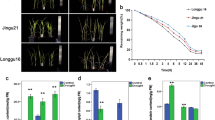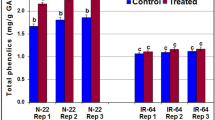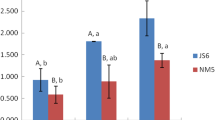Abstract
Drought, one of the crucial environmental constraints, seriously threats the quality and yield in chieh-qua. Therefore, cultivating drought-tolerant variety is greatly necessary for its normal growth under water deficiency. However, at present, molecular knowledge on drought resistance is mostly unclear in chieh-qua. In the study, characteristics of two diverse genetic chieh-qua variety, A39 (drought-resistance) and H5 (drought-sensitivity), were analyzed. Under drought stress, H5 exerted high water loss rate, increased malonaldehyde (MDA) content, and decreased enzyme activity of glutathione peroxidase (GSH-PX) and superoxide dismutase (SOD) compared with A39. In addition, based on the transcriptome results, we obtained a total of 1821 (511 up-regulated and 1310 down-regulated) and 2114 (1282 up-regulated and 832 down- regulated) differentially expressed genes (DEGs) in the A39 versus H5 under normal and water-deficiency stress, respectively. Several DEGs involved in the cuticle synthesis (cytochrome P450 genes: CYP94A2, CYP86B1, CYP86A7), carbohydrate metabolism, and plant hormone signal transduction (small auxin-up RNA genes: SAUR32, SAUR72; JA-induced genes: TIFY 10A, TIFY 10C; ABA related genes: PYL2, PYL4) were explored and related to drought resistance. These expression patterns observed in the RNA-seq data were further confirmed with quantitative real-time PCR (qRT-PCR). In all, these results not only provided a new insight into analyzing genes of drought response, but also laid a foundation for isolating crucial genes involved in drought stress in chieh-qua.









Similar content being viewed by others
References
Aarts MG, Keijzer CJ, Stiekema WJ et al (1995) Molecular characterization of the CER1 gene of arabidopsis involved in epicuticular wax biosynthesis and pollen fertility. Plant Cell 7:2115–2127
Abid M, Tian Z, Hu J et al (2017) Activities of carbohydrate-metabolism enzymes in pre-drought primed wheat plants under drought stress during grain filling, carbohydrate metabolism in drought primed wheat plants. J Integr Plant Biol 46:783–795
Al Hakimi A, Monneveux P, Galiba G (1995) Soluble sugars, proline and relative water content (RCW) as traits for improving drought tolerance and divergent selection for RCW from triticumpolonicum into triticum durum. J Genet Breed 49:237–244
Anjum SA, Tanveer M, Hussain S et al (2016) Exogenously applied methyl jasmonate improves the drought tolerance in wheat imposed at early and late developmental stages. Acta Physiol Plant 38:25
Bartels D, Sunkar R (2005) Drought and salt tolerance in plants. Crit Rev Plant Sci 24:23–58
Chung HS, Koo AJ, Gao X et al (2008) Regulation and function of Arabidopsis Jasmonate ZIM-domain genes in response to wounding and herbivory. Plant Physiol 146:952–964
Demianski AJ, Chung KM, Kunkel BN (2012) Analysis of Arabidopsis JAZ gene expression during Pseudomonas syringae pathogenesis. Mol Plant Pathol 13:46–57
Devoto A (2010) Jasmonate-regulated Arabidopsis stress signaling network. Physiol Plant 123:161–172
Du H, Wu N, Fu J et al (2012) A GH3 family member, OsGH3-2, modulates auxin and abscisic acid levels and differentially affects drought and cold tolerance in rice. J Exp Bot 63:6467–6480
Fan M, Huang Y, Zhong Y et al (2014) Comparative transcriptome profiling of potassium starvation responsiveness in two contrasting watermelon genotypes. Planta 239:397–410
Gan X, Stegle O, Behr J et al (2011) Multiple reference genomes and transcriptomes for Arabidopsis thaliana. Nature 477:419–423
Greer S, Wen M, Bird D et al (2007) The cytochrome P450 enzyme CYP96A15 is the midchain alkane hydroxylase responsible for formation of secondary alcohols and ketones in stem cuticular wax of Arabidopsis. Plant Physiol 145:653–667
Hagen G, Guilfoyle Τ (2002) Auxin-responsive gene expression, genes, promoters and regulatory factors. Plant Mol Biol 49:373–385
He XM, Xie DS, Chen QH, Peng QW (2007) Chieh-qua biotechnology, progress and prospects. Asia Aust J Sci Biotech 1:19–22
Kant S, Bi YM, Rothstein ZSJ (2009) SAUR39, a small auxin-up RNA gene, acts as a negative regulator of auxin synthesis and transport in rice. Plant Physiol 151:691–701
Kandel S, Sauveplane V, Olry A et al (2006) Cytochrome P450-dependent fatty acid hydroxylases in plants. Phytochem Rev 5:359–372
Kanehisa M, Araki M, Goto S et al (2008) KEGG for linking genomes to life and the environment. Nucleic Acids Res 36:480–484
Keller F, Ludlow MM (1993) Carbohydrate metabolism in drought-stressed leaves of Pigeonpea (Cajanus cajan). J Exp Bot 44:1351–1359
Kim H, Lee K, Hwang H et al (2014) Overexpression of PYL5 in rice enhances drought tolerance, inhibits growth, and modulates gene expression. J Exp Bot 65:453–464
Knight H (2000) Calcium signaling during abiotic stress in plants. Int Rev Cytol 195:269–325
Li CY, Deng GM, Yang J et al (2012a) Transcriptome profiling of resistant and susceptible Cavendish banana roots following inoculation with Fusarium oxysporum f. sp. Cubensetropical race 4. BMC Genom 13:374
Li Y, Feng D, Zhang D et al (2012b) Rice MAPK phosphatase IBR5 negatively regulates drought stress tolerance in transgenic Nicotiana tabacum. Plant Sci 188:10–18
Ma Y, Szostkiewicz I, Korte A et al (2009) Regulators of PP2C phosphatase activity function as abscisic acid sensors. Science 324:1064–1068
Ma Y, Qin F (2014) ABA regulation of plant responses to drought and salt stresses. Abscisic acid: metabolism, transport and signaling. Springer, Dordrecht, pp 315–336
Menard R, Verdier G, Ors M et al (2014) Histone H2B monoubiquitination is involved in the regulation of cutin and wax composition in Arabidopsis thaliana. Plant Cell Physiol 55:455–466
Miller GAD, Suzuki N, Ciftci-Yilmaz S, Mittler RON (2010) Reactive oxygen species homeostasis and signalling during drought and salinity stresses. Plant Cell Environ 33:453–467
Mohammadkhani N, Heidari R (2008) Drought-induced accumulation of soluble sugars and proline in two maize varieties. World Appl Sci J 3:448–453
Nguyen GN, Hailstones DL, Wilkes M, Sutton BG (2010) Drought stress, role of carbohydrate metabolism in drought-induced male sterility in rice anthers. J Agron Crop Sci 196:346–357
Ning J, Li X, Hicks LM, Xiong L (2010) A raf-like MAPKKK gene DSM1 mediates drought resistance throughreactive oxygen speciesscavenging in rice. Plant Physiol 152:876–890
Paranidharan V, Palaniswami A, Vidhyasekaran P, Velazhahan R (2005) A host-specific toxin of Rhizoctonia solani triggers superoxide dismutase (SOD) activity in rice. Archiv für Pflanzenschutz 38:151–156
Park SY, Fung P, Nishimura N et al (2009) Abscisic acid inhibits type 2C protein phosphatases via the PYR/PYL family of START proteins. Science 324:1068–1071
Samuels L, Kunst L, Jetter R (2008) Sealing plant surfaces, cuticular wax formation by epidermal cells. Plant Biol 59:683–707
Saavedra X, Modrego A, Rodriguez D et al (2010) The nuclear interactor PYL8/RCAR3 of Fagus sylvatica FsPP2C1 is a positive regulator of abscisic acid signaling in seeds and stress. Plant Physiol 152:133–150
Santiago J, Rodrigues A, Saez A et al (2009) Modulation of drought resistance by the abscisic acid receptor PYL5 through inhibition of clade A PP2Cs. Plant J 60:575–588
Seo JS, Joo J, Kim MJ et al (2011) OsbHLH148, a basic helix-loop-helix protein, interacts with OsJAZ proteins in a jasmonate signaling pathway leading to drought tolerance in rice. Plant J 65:907–921
Shen H, Liu C, Zhang Y et al (2012) OsWRKY30 is activated by MAP kinases to confer drought tolerance in rice. Plant Mol Biol 80:241–253
Shi H, Chen L, Ye T et al (2014) Modulation of auxin content in Arabidopsis confers improved drought stress resistance. Plant Physiol Biochem 82:209–217
Shinozaki K (2002) Important roles of drought-and cold inducible genes for galactinol synthase in stress tolerance in Arabidopsis thaliana. Plant J 29:417–426
Sperdouli I, Moustakas M (2012) Interaction of proline, sugars, and anthocyanins during photosynthetic acclimation of Arabidopsis thaliana to drought stress. J Plant Physiol 169:577–585
Sun L, Wang YP, Chen P et al (2011) Transcriptional regulation of SlPYL, SlPP2C, and SlSnRK2 gene families encoding ABA signal core components during tomato fruit development and drought stress. J Exp Bot 62:5659–5669
Taji T, Ohsumi C, Iuchi S et al (2012) The expression profiling of the CsPYL, CsPP2C and CsSnRK2 gene families during fruit development and drought stress in cucumber. J Plant Physiol 169:1874–1882
Tamiru M, Undan JR, Takagi H et al (2015) A cytochrome P450, OsDSS1, is involved in growth and drought stress responses in rice (Oryza sativa L.). Plant Mol Biol 88:85–99
Thompson AJ, Jackson AC, Parker RA et al (2000) Abscisic acid biosynthesis in tomato: regulation of zeaxanthin epoxidase and 9-cis-epoxycarotenoid dioxygenase mRNAs by light/dark cycles, water stress and abscisic acid. Plant Mol Biol 42:833–845
Ullah A, Sun H, Yang X et al (2017) Drought coping strategies in cotton: increased crop per drop. Plant Biotechnol J 15:271–284
Vandesompele J, de Preter K, Pattyn F et al (2002) Accuratenormalization of real-time quantitative RT-PCR data by geometric averaging of multiple internal controlgenes. Genome Biol 3:RESEARCH0034–RESEARCH41
Verma V, Ravindran P, Kumar PP (2016) Plant hormone-mediated regulation of stress responses. BMC Plant Biol 16:86
Wang W, Zhang Y, Xu C et al (2015a) Cucumber ECERIFERUM1, (CsCER1), which influences the cuticle properties and drought tolerance of cucumber, plays a key role in VLC alkanes biosynthesis. Plant Mol Biol 87:219–233
Wang J, Zhang L, Cao Y et al (2018a) CsATAF1 positively regulates drought stress tolerance by ABA-dependent pathway and promoting ROS scavenging in cucumber. Plant Cell Physiol 59:930–945
Wang M, Jiang B, Peng Q et al (2018b) Transcriptome analyses in different cucumber cultivars provide novel insights into drought stress responses. Int J Mol Sci 19:2067
Wang M, Jiang B, Liu WR et al (2019) Transcriptome analyses provide novel insights into heat stress responses in chieh-qua (Benincasa hispida Cogn. var. Chieh-Qua How). Int J Mol Sci 20:883
Wang W, Zhang Y, Xu C et al (2015b) Cucumber ECERIFERUM1, (CsCER1), which influences the cuticle properties and drought tolerance of cucumber, plays a key role in VLC alkanes biosynthesis. Plant Mol Biol 87:219–233
Xiong L, Zhu JK (2002) Molecular and genetic aspects of plant responses to osmotic stress. Plant Cell Environ 25:131–139
Xin M, Wang L, Liu Y et al (2017) Transcriptome profiling of cucumber genome expression in response to long-term low nitrogen stress. Acta Physiol Plant 39:130
Yang Y, Mo Y, Yang X et al (2016) Transcriptome profiling of watermelon root in response to short-term osmotic stress. PLoS ONE 11:e0166314
Ye J, Fang L, Zheng H et al (2006) WEGO, a web tool for plotting GO annotations. Nucleic Acids Res 34:W293
Zeevaart JAD, Creelman RA (1988) Metabolism and physiology of abscisic acid. Annu Rev Plant Physiol Plant Mol Biol 39:439–473
Zhang J, Jia W, Yang J et al (2006) Role of ABA in integrating plant responses to drought and salt stresses. Field Crops Res 97:111–119
Zhang Z, Wang Y, Chang L et al (2016) MsZEP, a novel zeaxanthin epoxidase gene from alfalfa (Medicago sativa), confers drought and salt tolerance in transgenic tobacco. Plant Cell Rep 35:439–453
Zhao G, Song Y, Wang C et al (2016) Genome-wide identification and functional analysis of the TIFY gene family in response to drought in cotton. Mol Genet Genom 291:2173–2187
Zhou L, Ni E, Yang J et al (2013) Rice OsGL1-6 is involved in leaf cuticular wax accumulation and drought resistance. PLoS ONE 8:e65139
Zhu JK (2002) Salt and drought stress signal transduction in plants. Annu Rev Plant Biol 53:247–273
Acknowledgements
This work was supported by the Natural Science Foundation of Guangdong Province (2018A030310196), the Guangdong Special Project Youth Top-notch Talent Project (2016TQ03N529), the Natural Science Foundation of Guangdong Province (2018A030313495), the Science and Technology Program of Guangdong (2018B020202007), and the National Key Research and Development Programme (2018YFD0100700). We were appreciated for Dr. Jin Ma from the National Heart, Lung, and Blood Institute, National Institutes of Health, Bethesda, Maryland, USA for her critical reading and polishing of the manuscript.
Author information
Authors and Affiliations
Corresponding author
Additional information
Publisher's Note
Springer Nature remains neutral with regard to jurisdictional claims in published maps and institutional affiliations.
Electronic supplementary material
Below is the link to the electronic supplementary material.
Rights and permissions
About this article
Cite this article
Wang, M., He, X., Jiang, B. et al. Transcriptome analysis in different chieh-qua cultivars provides new insights into drought-stress response. Plant Biotechnol Rep 13, 663–675 (2019). https://doi.org/10.1007/s11816-019-00564-x
Received:
Accepted:
Published:
Issue Date:
DOI: https://doi.org/10.1007/s11816-019-00564-x




